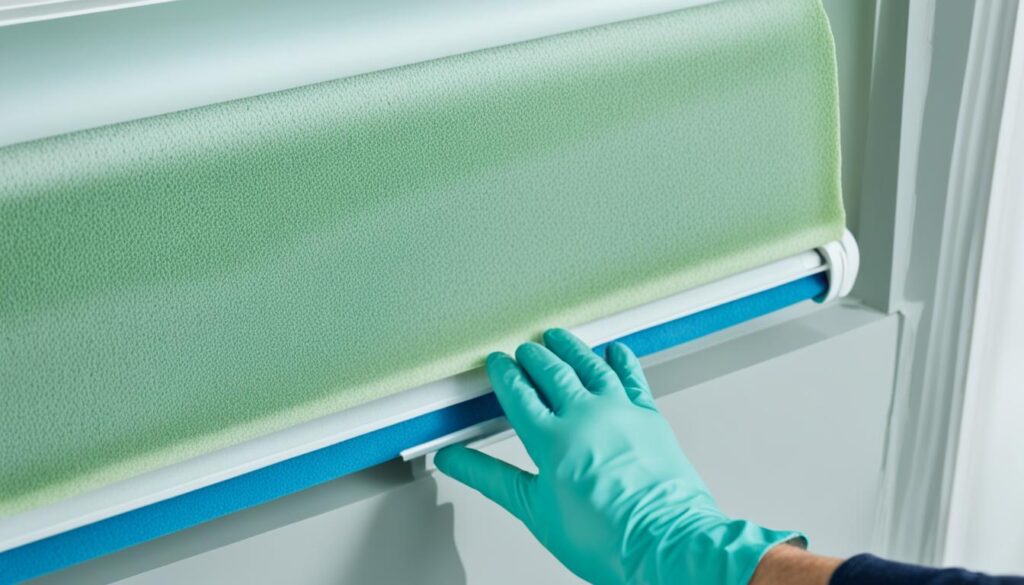
Mold & Mildew Removal Guide for Roller Blinds
Welcome to our comprehensive guide on mold and mildew removal for roller blinds. If you’ve noticed mold growth or mildew stains on your roller blinds, it’s essential to address the issue promptly to maintain a clean and healthy living space. In this guide, we will provide you with step-by-step instructions on how to effectively remove mold and mildew from your roller blinds, as well as tips to prevent their recurrence in the future.
Key Takeaways:
- Regular cleaning and maintenance are crucial to prevent mold and mildew growth on roller blinds.
- Use proper cleaning solutions and tools to ensure thorough and safe removal of mold and mildew.
- Proper ventilation and moisture control in the room can help prevent mold and mildew formation.
- Drying your roller blinds thoroughly after cleaning is essential to prevent moisture buildup.
- If mold contamination is extensive, consider professional mold assessment and remediation services.
How to Remove Mold and Mildew from Roller Blinds
When it comes to maintaining the cleanliness and appearance of your roller blinds, removing mold and mildew is essential. Mold and mildew not only ruin the aesthetics of your window treatments but can also pose health risks. In this section, we’ll guide you through the step-by-step process of effectively removing mold and mildew from your roller blinds.
Necessary Tools and Cleaning Solutions
Before you begin the mold removal process, gather the following tools and cleaning solutions:
- Mildew-specific cleaner or a mixture of water and mild dish soap
- Soft brush or sponge
- Microfiber cloth or towel
- Vacuum cleaner with a brush attachment
- Small bucket or basin
- Protective gloves and a mask
- Vinegar (optional)
Step-by-Step Cleaning Instructions
Follow these detailed steps to clean mold and mildew from your roller blinds:
- Begin by removing the roller blinds from the window. Check the manufacturer’s instructions for specific guidance on how to detach the blinds.
- Once the blinds are removed, lay them flat on a clean and dry surface.
- Inspect the blinds for any visible mold or mildew. If you spot any, use a vacuum cleaner with a brush attachment to remove loose spores and debris.
- Prepare a cleaning solution by mixing water with a mildew-specific cleaner or mild dish soap. Avoid using bleach, as it can damage the fabric or material of the blinds.
- Dip a soft brush or sponge into the cleaning solution and gently scrub the affected areas of the blinds. Focus on areas with visible mold or mildew growth.
- Rinse the brush or sponge frequently in clean water to prevent spreading the mold or mildew to unaffected areas of the blinds.
- For stubborn mold or mildew stains, you can also use a mixture of vinegar and water. Apply the solution directly to the stains and let it sit for a few minutes before scrubbing.
- Once the cleaning process is complete, rinse the blinds thoroughly with clean water. Make sure to remove all traces of the cleaning solution.
- Gently squeeze out excess water from the blinds and allow them to air dry completely. Avoid direct sunlight, as it can cause discoloration or warping.
- Once the blinds are dry, reattach them to the window following the manufacturer’s instructions.
Tips to Prevent Future Mold and Mildew Growth
Now that your roller blinds are clean, it’s important to take preventive measures to avoid mold and mildew growth in the future. Consider the following tips:
- Regularly inspect your blinds for signs of moisture or mold. If you notice any, take immediate action to prevent further growth.
- Keep the area around your blinds well-ventilated to prevent excess humidity buildup.
- Avoid placing wet or damp items near the blinds.
- Consider using mold-resistant roller blinds or window treatments in high-moisture areas, such as bathrooms or kitchens.
- Periodically clean your blinds using a mild detergent or a mixture of vinegar and water to discourage mold and mildew growth.
By following these cleaning instructions and preventive tips, you can effectively remove mold and mildew from your roller blinds and ensure a clean and healthy living environment.
Quote
“Regularly inspecting and cleaning your roller blinds is crucial in preventing mold and mildew growth. By taking proactive measures, you can maintain the beauty and longevity of your window treatments.” – Patricia Thompson, Home Decor Expert

| Cleaning Solutions | Pros | Cons |
|---|---|---|
| Mildew-specific cleaner | – Designed to target mold and mildew – Can provide effective results |
– May contain harsh chemicals – Can be expensive |
| Mild dish soap and water | – Readily available – Gentle on fabrics |
– May require more effort to remove tough stains |
| Vinegar and water mixture | – Natural alternative – Can kill mold spores |
– Strong odor – May not be as effective on stubborn stains |
Conclusion
In conclusion, following our mold and mildew removal guide for roller blinds will ensure a fresh and hygienic home environment. By implementing regular cleaning and preventive measures, you can keep your roller blinds free from mold and mildew, creating a clean and healthy space for you and your family.
Remember, prevention is key in maintaining the longevity of your roller blinds. Regularly inspecting your blinds for any signs of mold or mildew and promptly addressing any issues will help mitigate the risk of fungal growth. Additionally, ensuring proper ventilation in areas where roller blinds are installed can aid in preventing excess moisture accumulation.
If you encounter persistent mold or mildew problems that require professional assistance, we recommend contacting Fix Mold Miami at 305-465-6653. Their team of experts provides mold assessment and remediation services to ensure a safe and mold-free living environment.




